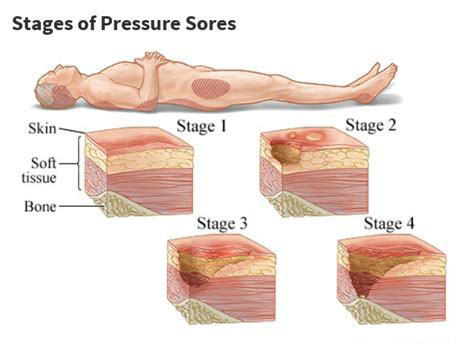Pressure ulcers, also bedsores. Kosiak created the first animal model of pressure ulcer in 1961. Follow-up researchers gradually explored the factors that lead to pressure ulcer and its mechanism. Traditionally, ischemic injury caused by external force is considered as the main factor of pressure ulcer. At present, it is thought that pressure ulcer is the result of the combination of pressure, friction force and shearing force with many kinds of internal and external factors. The most basic, the most direct, the most important reason is that oppression caused by ischemia and hypoxia, resulting in the normal functioning of the city degeneration, ulceration and necrosis.

1. Sustained pressure
Is the most important factor in skin damage. Is from the body’s own body weight and attached to the body’s force, the normal capillary pressure is 2 ~ 4kpa, externally applied pressure exceeds 4kpa, pressure duration of more than 2-4h, it will affect the local tissue microcirculation , Limiting blood flow, causing soft tissue ischemia, resulting in pressure sores.
2. Shear force
Is the second cause of pressure ulcers. Refers to the different levels or parts of the organization in different directions when the movement of a kind of force is applied to the surface of adjacent objects, causing the parallel force in the opposite direction of the parallel slide. It acts on the human skin deep, can cause the relative displacement of tissue, can cut off the blood supply to a large area, leading to tissue oxygen tension decreased, while tissue perforated blood vessels are stretched, twisted and tearing, can trigger deep necrosis. Therefore, the shear stress is more dangerous than the vertical pressure. Such as supine patients lift the bed more than 30 °, the wheelchair patient’s body tend to move forward in the sacrococcygeal and ischial tuberosity greater pre-shear force, can greatly reduce the tissue flow caused by the stop The pressure needed to cause the body to glide along with the hip next to the patient when the patient is in the semi-recumbent position will follow the movement of the bone. However, the skin and subcutaneous tissue can not move due to the friction between the skin and the sheets, , Resulting in skin tissue damage. Shearing force lasting more than 30min can cause irreversible damage to deep tissues.
3. Friction
Friction is the traction of the skin when the center of gravity of the body moves in the opposite direction, that is, friction. Drag the patient when moving the action, wrinkled bed sheets or debris are common clinical sources of friction. Friction can destroy the keratinized layer of the skin, separating the superficial cells of the epidermis from the basal cells, causing congestion, edema, hemorrhage, accumulation of inflammatory cells and dermal necrosis. At the same time as the role of skin barrier damage, easy invasion of pathogenic microorganisms, tissues are more vulnerable to stress injury. In addition friction can make the local temperature, contributed to the emergence of metabolic disorders and pressure ulcers eventually formed.
Leave a Reply